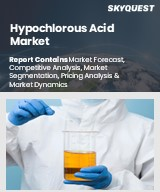
세계의 차아염소산 시장 규모는 2023년에 31억 달러로 평가되며, 2024년 32억 달러에서 2032년에는 52억 달러로 성장하며, 예측 기간(2025-2032년)의 CAGR은 4.4%로 성장할 전망입니다.
세계 차아염소산 시장은 위생 및 공중보건에 대한 인식이 높아짐에 따라 효과적인 살균제에 대한 수요가 증가함에 따라 확대되고 있습니다. 가정, 병원, 학교, 공공장소 등 다양한 환경에서 표면 소독의 효과로 인해 감염 제어를 위한 최선의 선택으로 확고히 자리매김하고 있습니다. 지속가능성과 화학물질에 대한 노출을 줄이는 추세는 친환경 세정 솔루션에 대한 관심이 높아지는 추세와 맞물려 있습니다. 또한 규제 당국의 차아염소산 승인은 기존 소독제를 대체할 수 있는 안전한 대안으로 차아염소산의 채택을 강화하고 있습니다. 인공지능, 머신러닝, 사물인터넷, 블록체인 등의 기술 발전은 생산 효율을 높이고, 제품의 무결성을 보장하며, 시장에서의 기술 혁신을 촉진하고, 무해하고 생분해성 소독제 옵션에 대한 선호도가 높아지는 추세에 대응하고 있습니다.
Global Hypochlorous Acid Market size was valued at USD 3.1 Billion in 2023 and is poised to grow from USD 3.2 Billion in 2024 to USD 5.2 Billion by 2032, growing at a CAGR of 4.4% in the forecast period (2025-2032).
The global hypochlorous acid market is expanding due to increasing demand for effective disinfectants driven by heightened awareness of hygiene and sanitation. Its effectiveness for surface disinfection in various settings, such as homes, hospitals, schools, and public spaces, solidifies its position as a preferred choice for infection control. The trend towards sustainability and reduced chemical exposure aligns with the rising interest in eco-friendly cleaning solutions. Additionally, the endorsement of hypochlorous acid by regulatory bodies reinforces its adoption as a safer alternative to conventional disinfectants. Technological advancements, including artificial intelligence, machine learning, IoT, and blockchain, are enhancing production efficiency, ensuring product integrity, and promoting innovation in the market, catering to the growing preference for non-toxic and biodegradable disinfectant options.
Top-down and bottom-up approaches were used to estimate and validate the size of the Global Hypochlorous Acid market and to estimate the size of various other dependent submarkets. The research methodology used to estimate the market size includes the following details: The key players in the market were identified through secondary research, and their market shares in the respective regions were determined through primary and secondary research. This entire procedure includes the study of the annual and financial reports of the top market players and extensive interviews for key insights from industry leaders such as CEOs, VPs, directors, and marketing executives. All percentage shares split, and breakdowns were determined using secondary sources and verified through Primary sources. All possible parameters that affect the markets covered in this research study have been accounted for, viewed in extensive detail, verified through primary research, and analyzed to get the final quantitative and qualitative data.
Global Hypochlorous Acid Market Segments Analysis
The global hypochlorous acid market is segmented by form, application, end user, and region. By form, the market is categorized into liquid, and gas and solid. Depending on application, it is categorized into disinfectant and sanitizers, water treatment, and food and beverages. Based on end user , it is classified into healthcare, agriculture, industrial and residential. Regionally, it is analyzed across North America, Europe, Asia-Pacific, Latin America, and the Middle East and Africa.
Driver of the Global Hypochlorous Acid Market
The Global Hypochlorous Acid market is driven by the substance's extensive antimicrobial capabilities, making it a popular choice in medical environments for its efficacy against a wide range of pathogens, including bacteria, viruses, and fungi. Its safety profile is notable, as it presents minimal health risks and does not produce harmful fumes, making it suitable for use around sensitive patients, healthcare professionals, and delicate equipment. Additionally, there is a growing endorsement from regulatory agencies and healthcare administrators for the integration of hypochlorous acid in hospitals and clinics, further fueling demand and utilization in various healthcare applications.
Restraints in the Global Hypochlorous Acid Market
The Global Hypochlorous Acid market faces several constraints due to the compound's inherent properties. Hypochlorous acid is a highly reactive substance that quickly degrades, leading to a diminished effectiveness soon after production. This degradation shortens its shelf life, complicating inventory management for manufacturers and distributors. Additionally, the specific storage requirements heighten logistical challenges and associated costs, particularly for large-scale operations and long-distance transportation. Consequently, this limited durability restricts the product's scalability and hampers its viability for emergency stockpiling, ultimately impacting its overall market potential and widespread adoption.
Market Trends of the Global Hypochlorous Acid Market
The Global Hypochlorous Acid market is increasingly driven by a strong consumer preference for non-toxic and eco-friendly disinfectants, as awareness of the health risks associated with traditional chemicals, such as ammonia and bleach, rises. Hypochlorous acid, which is naturally produced by the human immune system, stands out due to its efficacy at low concentrations and its gentle profile, minimizing risks of respiratory and skin issues. Its biodegradable properties further enhance its appeal among environmentally conscious consumers seeking to reduce their carbon footprint and chemical exposure, positioning hypochlorous acid as a viable alternative in a rapidly evolving disinfectant landscape.